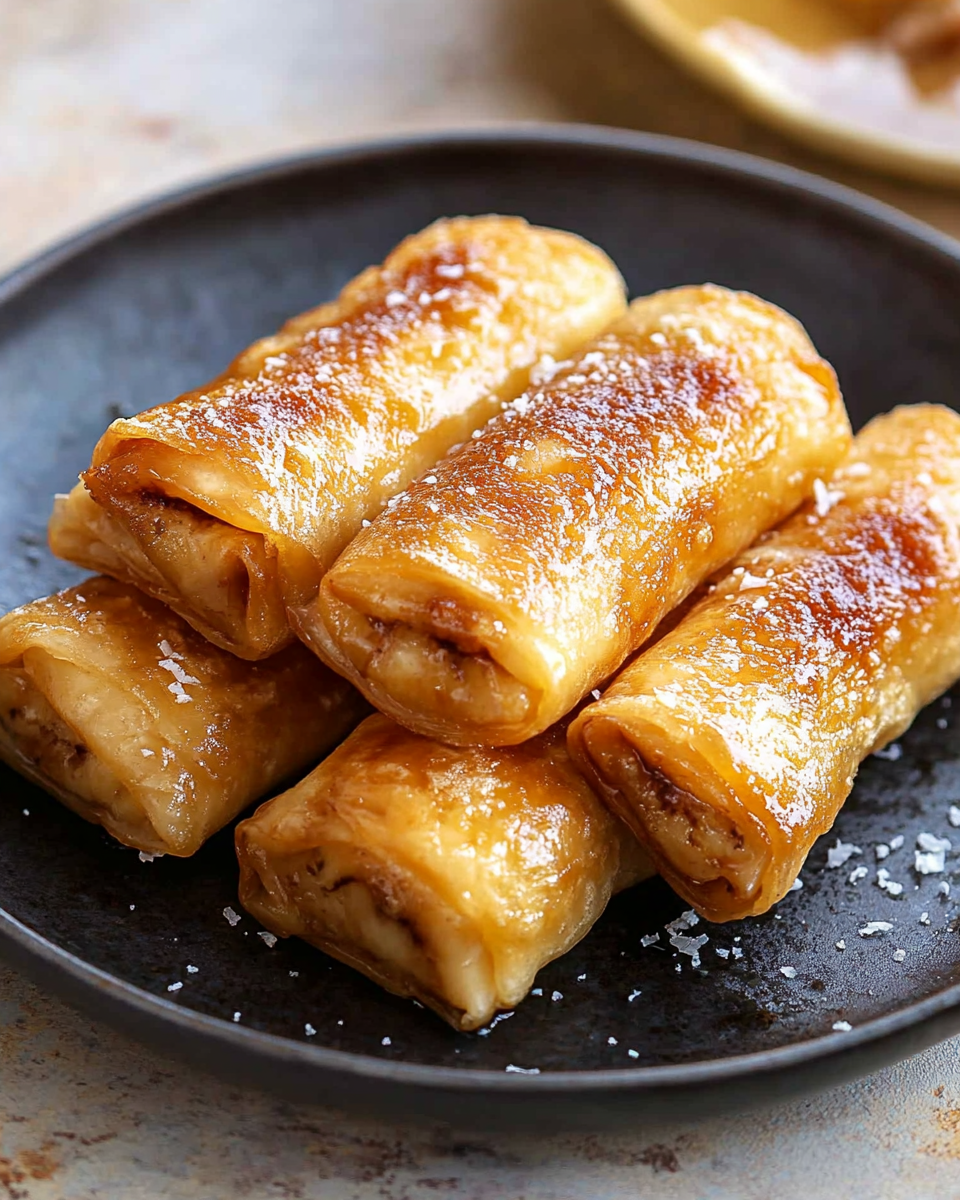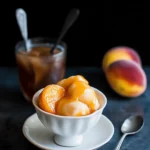This Crispy Banana Turon Rolls recipe features a delightful combination of sweet bananas wrapped in crispy spring roll wrappers, creating a delicious and satisfying snack or dessert. Perfect for a quick treat, these rolls are easy to make and can be enjoyed by both kids and adults alike.
FULL RECIPE
Ingredients
- 4 ripe saba bananas (or plantains)
- 8 spring roll wrappers
- 1/4 cup brown sugar
- 1/4 teaspoon ground cinnamon (optional)
- 1/4 cup sweetened coconut flakes (optional)
- 2 tablespoons butter or oil for frying
Directions
- Peel the bananas and cut them in half lengthwise.
- Place a spring roll wrapper on a clean surface.
- Sprinkle about 1 tablespoon of brown sugar (and cinnamon if using) onto the center of the wrapper.
- Lay a banana half on top of the sugar.
- Carefully fold the sides of the wrapper over the banana and roll it tightly, sealing the edges with a little water.
- Heat butter or oil in a frying pan over medium heat.
- Fry the wrapped bananas for 2-3 minutes on each side until golden and crispy.
- Remove the rolls from the pan and drain on paper towels.
- Optionally, sprinkle with sweetened coconut flakes before serving.
Nutritional Information
- Calories: 150-200 per roll
- Protein: 1-2g
- Carbohydrates: 35-40g
- Fat: 5-7g
- Sugar: 10-15g
The Origin of Turon
Turon, a beloved Filipino snack, has deep roots in Filipino cuisine. Often referred to as “banana lumpia,” this dish originated in the rural provinces of the Philippines. The traditional recipe consists of ripe bananas, typically saba bananas, which are wrapped in a spring roll wrapper and fried to perfection. The creation of Turon came from the need to make use of inexpensive and locally available ingredients, making it an affordable yet delicious treat that became a staple in the Philippines. Over time, different variations have emerged, with some incorporating sweet additions like jackfruit, sugar, and coconut flakes.
The Evolution of Turon Across Cultures
As Turon became more popular, it eventually spread beyond the Philippines to neighboring Southeast Asian countries and even to other parts of the world. Variations of the dish are now enjoyed in many cultures, with some making subtle changes to suit local tastes. For example, in some parts of the Philippines, Turon is made with sweetened coconut flakes and even condensed milk. This evolution has made the snack a versatile and adaptable dish that can be customized to individual preferences.
Why Banana Is the Star Ingredient
Bananas, particularly the saba variety used in Turon, are the heart and soul of this dish. Saba bananas are a staple in Filipino cooking because of their firmness and slight sweetness when cooked. These bananas are less sweet than other banana varieties, which makes them perfect for cooking and frying. Their ability to hold their shape during frying ensures that each bite of Turon has a satisfying texture. When combined with sugar and wrapped in a crisp spring roll wrapper, the banana’s sweetness and natural flavor shine.
The Secret to the Crispy Crunch
One of the most appealing aspects of Turon is the crispy texture of the wrapper. The contrast between the warm, soft banana inside and the crispy exterior makes each bite irresistible. The key to achieving this crispy texture lies in the choice of spring roll wrappers and the frying technique. The wrapper, when fried to the right golden brown color, adds a satisfying crunch that complements the soft banana filling. The right temperature of the oil is also crucial, as too hot or too cold oil can result in a greasy or undercooked wrapper.
Frying Techniques for Perfect Turon
Frying Turon to perfection requires some attention to detail. First, ensure the oil is preheated to the right temperature—around 350°F (175°C) is ideal. If the oil is too hot, the wrapper may burn before the banana is fully cooked. If the oil is too cold, the wrapper will absorb too much oil and become greasy. Frying in small batches helps maintain the correct oil temperature and ensures that each roll is evenly cooked. Turning the rolls carefully during frying ensures an even golden-brown color on all sides.
The Role of Brown Sugar in Sweetening Turon
Brown sugar plays a significant role in sweetening Turon. It adds depth of flavor and richness that white sugar cannot replicate. The molasses content in brown sugar gives the dish a slight caramel flavor that enhances the natural sweetness of the banana. When the brown sugar melts during frying, it creates a sticky, sweet coating that helps form a golden, crispy exterior. The sugar also balances the mild flavor of the saba bananas, making the overall taste more harmonious.
Adding Jackfruit for Extra Flavor
In many variations of Turon, jackfruit is added as a filling alongside the banana. Jackfruit’s sweetness and unique texture make it a perfect pairing with bananas. The combination of banana and jackfruit creates a tropical flavor profile that is beloved by many. Jackfruit’s fibrous texture provides a subtle contrast to the softness of the banana, while its natural sweetness amplifies the overall flavor of the Turon. If you’re looking to elevate your Turon experience, adding jackfruit is a great way to experiment with new flavors.
The Versatility of Turon Fillings
While the traditional Turon filling is just banana and sugar, there are endless ways to customize this treat. Other fillings like coconut, sweetened condensed milk, or even Nutella can be added to make the dish even more indulgent. You can experiment with various fruits like mango or pineapple for a tropical twist, or even try savory versions of Turon with cheese or vegetables. The beauty of Turon lies in its adaptability, allowing you to get creative and experiment with different ingredients that suit your taste preferences.
Serving Suggestions for Turon
Turon is typically enjoyed as a snack or dessert, but it can be served in various ways to suit different occasions. For a casual snack, serve the rolls fresh from the frying pan with a cup of coffee or tea. If you’re hosting a party or gathering, you can serve Turon as an appetizer or dessert, perhaps alongside other Filipino snacks like lumpia or empanadas. Turon can also be drizzled with chocolate sauce or sprinkled with powdered sugar for an extra indulgent treat.
How to Store Leftover Turon
If you have leftover Turon, storing it properly ensures it retains its flavor and texture. After the Turon has cooled down, store it in an airtight container at room temperature. However, keep in mind that the wrapper may lose some of its crispiness as it sits. To reheat, place the Turon in a preheated oven or air fryer for a few minutes to crisp it back up. This method helps restore the crunchiness without making the rolls greasy.
Healthier Alternatives for Making Turon
While traditional Turon is a delicious treat, it’s not the healthiest option due to the frying process and added sugar. For a healthier alternative, you can bake the Turon instead of frying it. This reduces the amount of oil and makes the snack less greasy. You can also opt for a sugar substitute like stevia or monk fruit to lower the sugar content. For a more nutrient-dense option, consider adding nuts like almonds or walnuts for added protein and healthy fats.
Pairing Turon with Beverages
The rich sweetness of Turon pairs wonderfully with a variety of beverages. A cup of hot coffee or tea balances the sweetness of the Turon, creating a satisfying snack experience. If you’re looking for a more refreshing option, serve the Turon with a glass of fresh fruit juice or coconut water. For a more indulgent treat, try pairing Turon with a scoop of vanilla ice cream or a milkshake. The cold and creamy texture of the ice cream contrasts nicely with the warm, crispy Turon.
The Appeal of Turon in Filipino Culture
Turon holds a special place in Filipino culture. It is often sold by street vendors, who roll the bananas in sugar and fry them on the spot for a quick and affordable snack. It is also a common snack served at Filipino parties, celebrations, and gatherings. The simplicity of the ingredients and the ease of preparation make it a beloved treat among families and friends. The act of preparing and sharing Turon is a cherished tradition that brings people together, whether it’s at a casual afternoon gathering or a festive celebration.
Making Turon for Special Occasions
While Turon is often enjoyed as an everyday snack, it can also be a special treat for celebrations and holidays. During the holiday season, for example, you can make Turon with festive variations such as adding cinnamon, cloves, or nutmeg for a spiced version. If you’re hosting a party, consider making mini Turon rolls to serve as bite-sized snacks for guests. Turon can also be incorporated into a dessert table alongside other Filipino sweets like leche flan or halo-halo.
The Importance of Fresh Ingredients
Fresh ingredients are key to making delicious Turon. Using ripe, but not overly ripe, saba bananas is essential to achieving the right balance of sweetness and firmness. Overripe bananas can turn mushy during frying, which may cause the rolls to lose their shape and texture. Fresh spring roll wrappers are also crucial, as stale wrappers may tear easily and fail to crisp properly. By using the freshest ingredients available, you ensure the best possible outcome for your Turon.
Making Turon a Family Activity
Making Turon can be a fun family activity that brings everyone together. Children can help with the wrapping process, making it an interactive experience that everyone can enjoy. This is a great way to introduce kids to cooking and give them a hands-on experience with food preparation. Plus, it’s an enjoyable way to bond as a family while creating a delicious treat that everyone can share.
The Influence of Street Vendors on Turon’s Popularity
Street vendors have played a significant role in making Turon a popular snack in the Philippines. These vendors are a common sight in many Filipino communities, offering freshly fried Turon for a small price. The convenience and affordability of this snack make it a go-to option for people on the move or those looking for a quick pick-me-up. Turon has become synonymous with Filipino street food culture, with vendors often customizing the rolls with different fillings and toppings to suit the tastes of their customers.
Advertisement
Why Turon is Perfect for On-the-Go Snacking
One of the reasons Turon is so popular is its portability. After being fried, it becomes easy to hold and eat, making it an ideal snack for people on the go. Whether you’re at a park, commuting, or attending an event, Turon is a convenient and satisfying option. Its compact size allows for easy transport, and it can be enjoyed without utensils, making it a perfect street food snack.
The Fun of Experimenting with Different Fillings
The versatility of Turon allows for endless possibilities when it comes to fillings. Beyond the traditional banana and sugar, you can experiment with a variety of fillings to create a unique twist on this classic snack. Some people enjoy adding sweet potato, ube, or even cheese to the filling for a savory-sweet combination. The beauty of Turon is that it can be tailored to individual tastes, so feel free to get creative with your fillings and toppings.
Conclusion
Turon is a delicious Filipino snack that has stood the test of time. Its simple ingredients, crispy texture, and sweet flavor have made it a beloved treat among people of all ages. Whether you stick to the classic banana filling or explore new variations, Turon is a versatile dish that can be enjoyed in many ways. It’s not only a snack but also a part of Filipino culture and tradition, making it a dish that brings people together. Whether fried or baked, sweet or savory, Turon is sure to delight with every bite.






